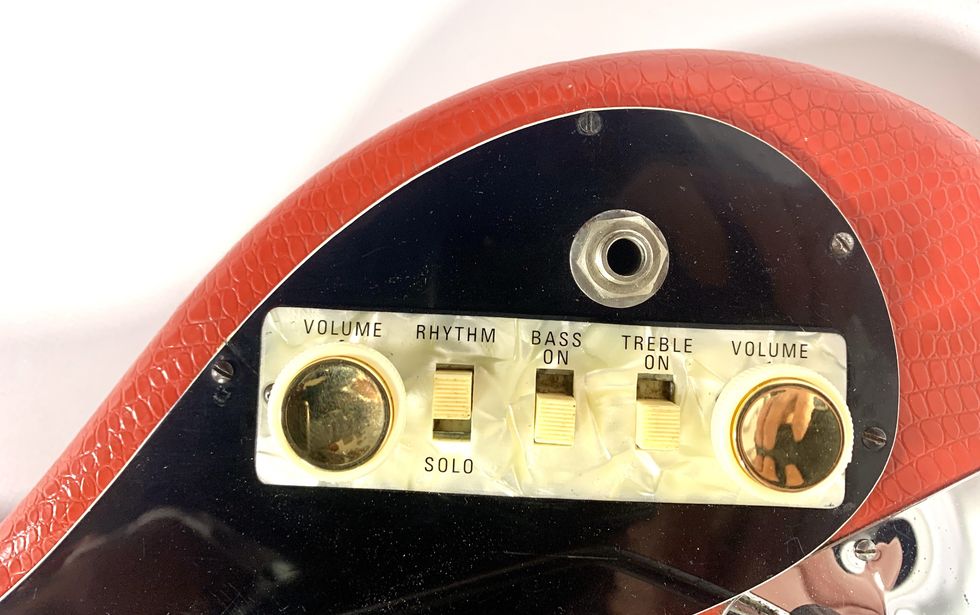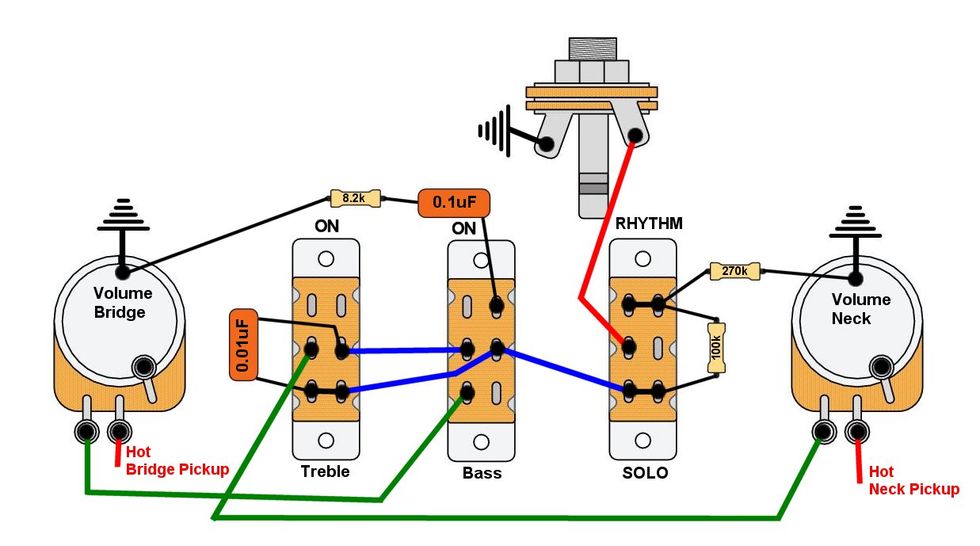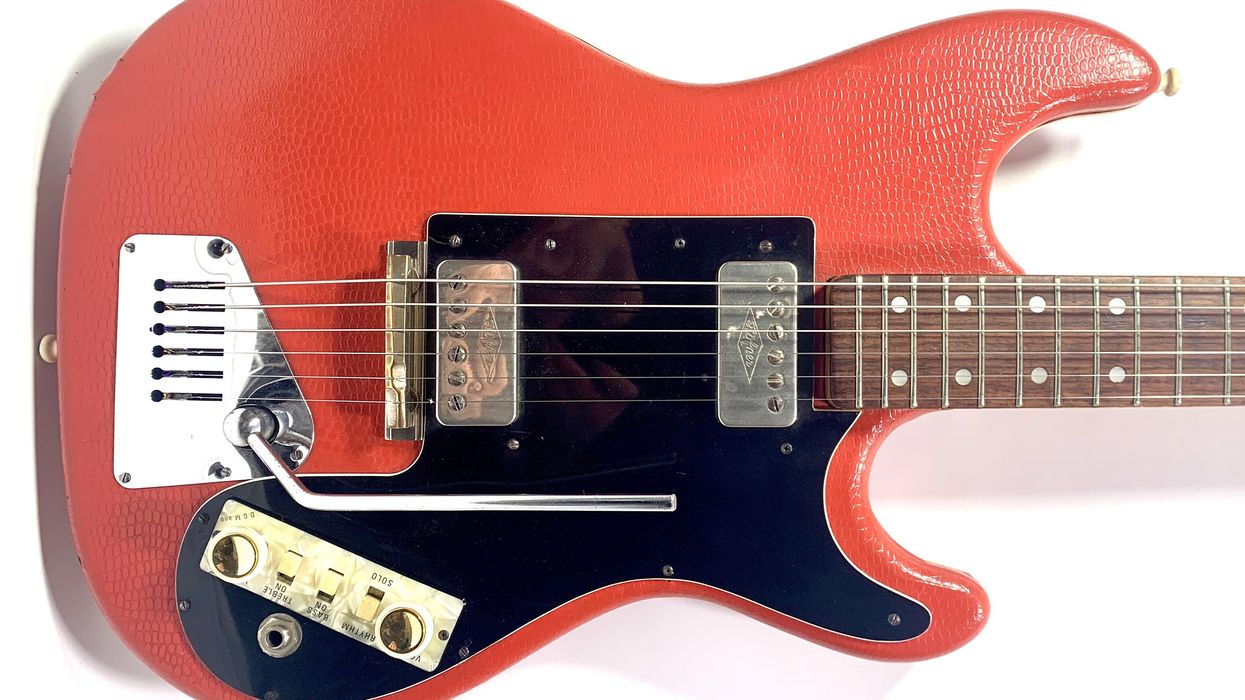Hello and welcome back to Mod Garage! In this column, we will have a look at the famous HA2B control-panel wiring from the German Höfner company (often written as “Hofner” without the German umlaut). The control plate became famous on the Höfner violin bass—the model 500/1 that was released in 1956 and is often referred to as the “Beatle Bass” because of Paul McCartney.
Höfner also used this wiring on a lot of their early solidbody electric guitars, like the famous model 172. These models were covered in colorful vinyl rather than receiving a paint job. The demand for electric guitars was very high in the ’60s, and a paint job was very time-consuming and expensive, so this method was a welcome alternative to cut costs and save time. The vinyl is still an eye-catcher today.
My first real electric guitar was such a Höfner, a later model without the control plate, but still covered in gorgeous red vinyl. Eventually, I removed the vinyl and put some dilettantish paint job on it. When I think about it today, I feel like a lemon.
Frank Meyers recently wrote a cool column about the Höfner company and its history, which appeared in PG’s March 2023 issue, so if you want to find out more about them, please check it out.
So, let’s have a look at the control plate and its very special wiring. It might be considered weird from today’s perspective, but at the time, this wiring was state of the art. The control plate itself and the fancy “tea cup” knobs are still available today—it is called HA2B with an additional letter indicating the color of the plastic control plate, e.g. B (black), C (cream), T (tortoise), and so on.

Photo 2
Photo courtesy of L’instrumenterie, Baptiste Zermati, Villeurbanne, France (https://linstrumenterie.com)
This wiring is designed for a guitar with two pickups and sports an individual on/off switch and volume control for each, plus a rhythm/solo switch, resulting in a total of two pots and three switches. Please note that the plate is labeled in English and not in German, which clearly shows that Höfner was targeting the international market while still selling large quantities inside Germany.
Here is a short summary of what the individual controls are doing, using Photo 2 as our reference:
• neck pickup volume pot
• solo = full output signal / rhythm = output attenuated to about 70 percent
• bass off = bridge pickup on / bass on = bridge pickup off + treble filter
• treble off = neck pickup on / treble on = neck pickup off + bass filter
• bridge pickup volume pot
The way the bass and treble switches are wired up is the real weird part. Back in the day, a neck pickup was often referred to as the bass pickup and the bridge pickup the treble pickup. In this case, the bass switch is for the treble pickup and vice versa. So when the bass switch is off, the bridge pickup is on; when it’s on, the bridge pickup is off. And when the treble switch is off, the neck pickup is on; when it’s on, the neck pickup is off.
This results in the following: When both switches are in the off position, both pickups are engaged (in parallel), and when both switches are in the on position, both pickups are disabled, which works like a kill switch to mute the whole guitar.
This is, for sure, one of the fanciest guitar wirings ever. But believe me, compared to some wirings that were used in the electric guitars of the Musima company in the former GDR, this one here is as harmless as can be.
"There is no law against experimenting with the values of the caps and resistors to tweak the tone to your personal preferences."
Let’s have a look what’s under the hood:
2 x 250k audio pots
3 x DPDT slide switches
1 x 270k + 1 x 100k resistors for the solo/rhythm switch
1 x 0.01 uF treble cap
1 x 0.1 uF bass cap + 1 x 8.2k resistor
You can use any cap and resistor you want. I like to use small film caps and 1/4-watt metal film resistors. It’s nice working with these parts because they are small enough to fit the control plate.
The wiring works as follows:
Solo/rhythm switch: While the solo position has full signal output, the rhythm position engages two resistors to reduce the output to approximately 70 percent by bleeding some signal to ground.
Bass switch: In the on position, the bass capacitor and the resistor filters some highs off to ground.
Treble switch: In the on position, the treble capacitor filters some bass off to ground.
So, here we go for the wiring:

Fig. 1
Illustration courtesy of SINGLECOIL (www.singlecoil.com)
This is the real deal circuit that Höfner used in the early ’60s. The modern overhauled wiring of the HA2B circuit looks very similar, but uses a 0.1 uF treble cap and has no additional resistor in-line with the bass cap. To my ears, the vintage version sounds better, but this is a matter of taste and there is no law against experimenting with the values of the caps and resistors to tweak the tone to your personal preferences.
I would like to thank Baptiste Zermati from the L’instrumenterie company in France for the photos of the vintage Höfner 172—a big shoutout to him.
That’s it! Next month, we will talk about the brand new PRS “Dead Spec” Silver Sky wiring for John Mayer and how you can adopt this for your own Stratocaster, so stay tuned!
Until then ... keep on modding!






































